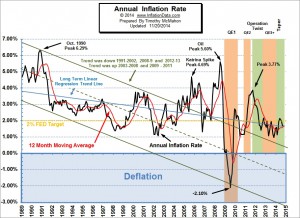The Bureau of Labor Statistics released the Inflation rate for the month of October today. Annual inflation remained steady at 1.66% even though prices fell from the month previous (i.e. monthly inflation was -0.25%). However, since monthly inflation was -0.26% in October 2013 annual inflation rates remained virtually identical as October 2013 was replaced by October 2014 in the calculations.
The FED has stated that it’s goal is to maintain inflation at a steady 2%. But as we can see from the chart they have rarely achieved that goal. If the goal was to remain below 2% we could say they have done very well since 2012 however during that time-period the FED has been fearing deflation rather than inflation and so even by though trillions have been earmarked as quantitative easing, quite often inflation has fallen well below 2% and often down to 1%.
 In our recent article Deflation: The Last Argument of Central Banks John Mauldin looked at “good” deflation vs. “bad” deflation, Austrian vs Monetarist vs Keynesian economics, causes of falling agricultural and manufactured goods prices, ShadowStats, hedonics, Asset Inflation Versus Price Inflation and more.
In our recent article Deflation: The Last Argument of Central Banks John Mauldin looked at “good” deflation vs. “bad” deflation, Austrian vs Monetarist vs Keynesian economics, causes of falling agricultural and manufactured goods prices, ShadowStats, hedonics, Asset Inflation Versus Price Inflation and more.
Over the last few months inflation has been relatively stable and according to the single digit calculations of the Bureau of Labor Statistics (BLS) they have actually been identical several of those months But using our two decimal place inflation calculations we get a slightly different picture. Using the BLS numbers for May through October you would see 2.1%, 2.1%, 2.0%, 1.7%, 1.7%, 1.7% and so a trend is not so obvious. But by looking at our 2 decimal place calculations we see May was 2.13% followed by 2.07%, 1.99%, 1.70%, 1.66% and finally October was also 1.66% so we see a steady decline.
As the inflation rate falls this is “disinflation” on an annual basis although July, August and October were “deflationary” on a monthly basis, i.e. each monthly number was below zero at -0.04%, -0.17%, -0.25% respectively.
Looking at the most recent two months… although they appear identical at first glance, they are not if we look at the components that make them up . From the table below we can see that over the 12 months prior both September and October have a total of 1.66% inflation but over the most recent 6 months the October values have only 0.15% inflation compared to 1.76% in September. Basically all of the inflation for the previous 12 months occurred from January through June of 2014. And a good chunk of it… 0.64% actually occurred in March. If you look at the table below you will see that in the most recent four months prices fell by -0.38% and November and December are notoriously deflationary. So unless we have another massively inflationary first half of 2015 inflation could rapidly turn to deflation and we could see the FED crank up the printing presses once again.
| Month | Sep-14 | Oct-14 |
| Index | 238.031 | 237.433 |
| 12 Month Change | 1.66% | 1.66% |
| 10 Month Change | 2.13% | 1.88% |
| 8 Month Change | 1.76% | 1.13% |
| 6 Month Change | 0.74% | 0.15% |
| 4 Month Change | 0.06% | -0.38% |
| 2 Month Change | -0.09% | -0.18% |
| 1 Month Change | 0.08% | -0.25% |
Recently we published an article by Bill Bonner entitled More Quantitative Easing in the Cards? Which shows that FED is addicted to Quantitative Easing (QE) and that it wouldn’t be so easy to kick the habit. Over the years we’ve published a variety of articles on the inherent “tug-of-war” between inflationary and deflationary forces in the world.
Including:
- How can we have Inflation and Deflation at the same time?
- Battle of the ‘Flations
- Deflation or Inflation – Which is it?
- Which is Stronger- Inflation or Deflation?
- Inflation or Deflation? – Yes
Another recurring theme has been Velocity of Money and Money Multiplier- Why Deflation is Possible


Leave a Reply